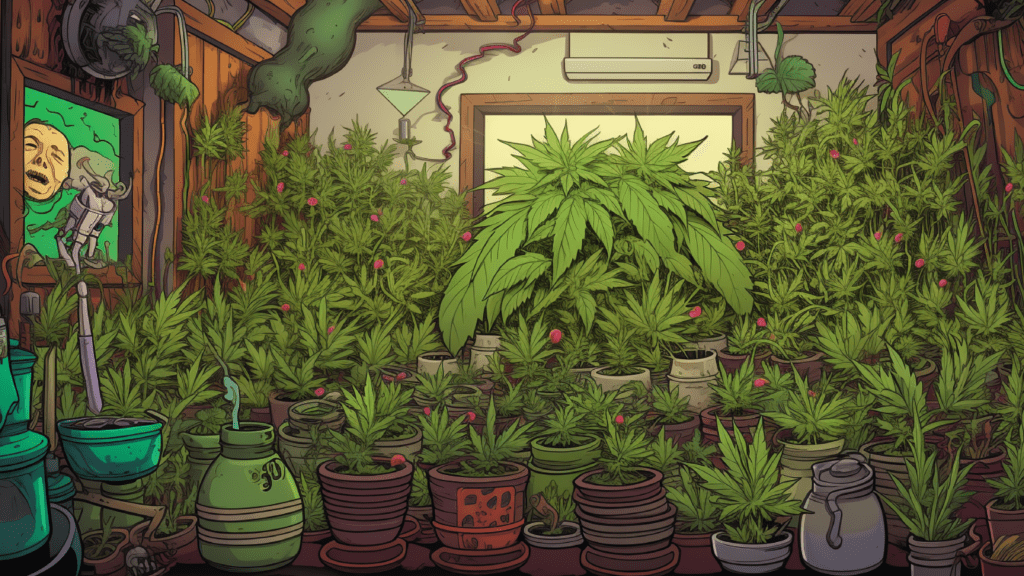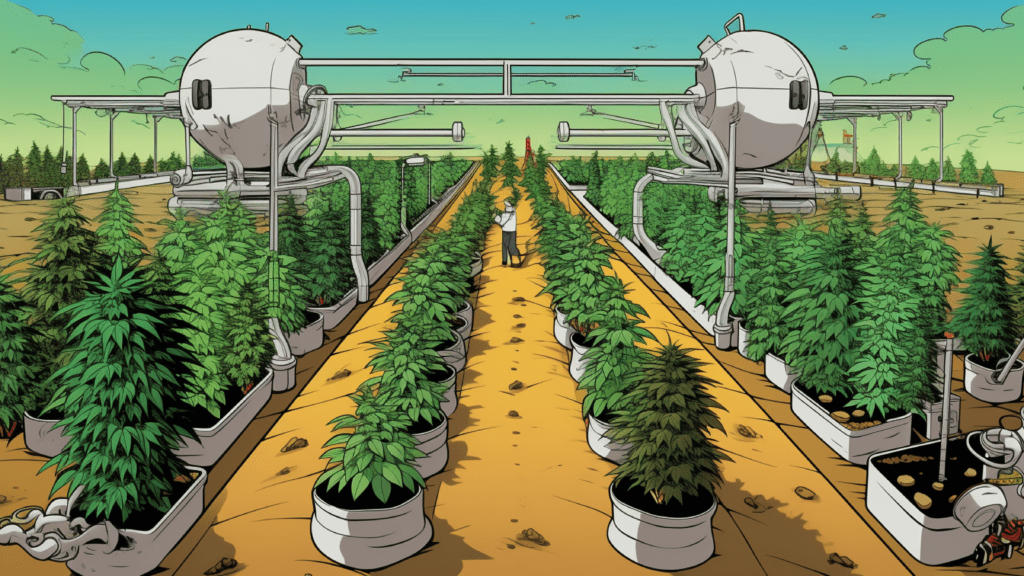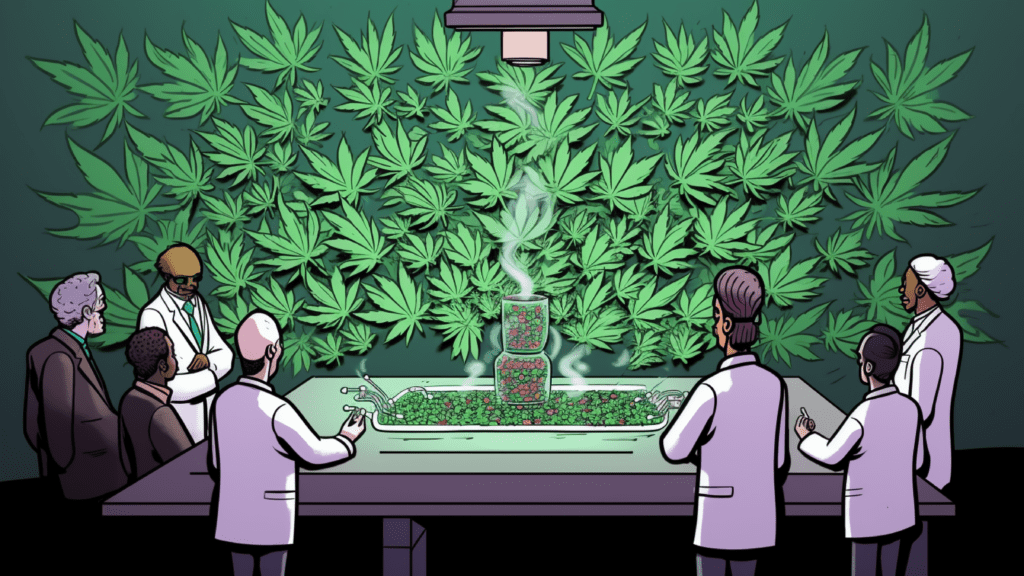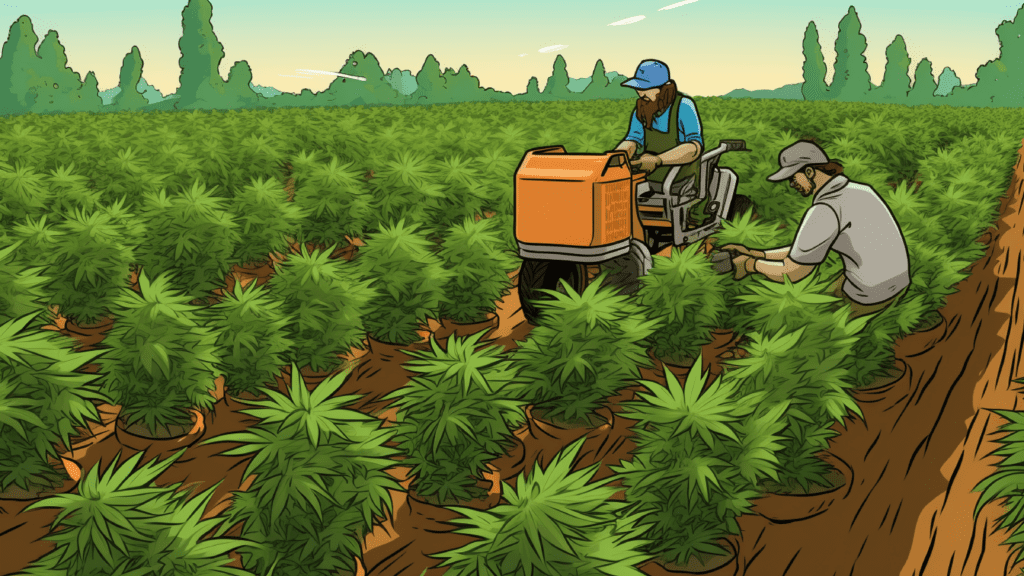Introduction
“The Art of Traceability” is a comprehensive guide on track-and-trace tailored specifically for the cannabis industry, with a special focus on Thai growers and the numerous cannabis enterprises based in Thailand. The Thai cannabis landscape has undergone a remarkable transformation since the decriminalization of cannabis in 2022, ushering in a paradigm shift and unprecedented growth. With the rapid increase in cultivation facilities and dispensaries, the need for effective traceability practices has become paramount.
Conceptual Framework and Cantrak
While Cantrak serves as a valuable Track and Trace system, this book is designed to provide essential insights into the conceptual framework of traceability. It caters not only to large enterprises but also to small-scale farms and individuals looking to solidify their understanding of Track and Trace, whether they are using a simple tool like Excel or Google Sheets.
Volume 1 Building the Foundation
In the first volume of “The Art of Traceability,” our primary objective is to establish key definitions essential for comprehending traceability concepts according to industry best practices. We delve into topics such as
1. Growing Location and Facility Understanding the significance of where cannabis is grown and the facilities involved in the cultivation process.
2. Inventory of Raw Materials and Harvested Products Managing and tracking the materials used in cultivation and the products harvested.
3. Plant Lot and Plants Exploring the intricacies of plant identification, grouping, and tracking.
4. Growth Stage and Location Monitoring the growth stages of cannabis plants and their specific locations.
5. Observations Documenting critical observations and data points throughout the cultivation process.
6. Waste Management Efficiently handling and documenting waste generated during cultivation.
7. Harvest Batches Establishing a systematic approach to tracking harvest batches for quality assurance.
Future Volumes Expanding Expertise
In future volumes, we aim to provide more hands-on approaches to performing Track and Trace. These may encompass post-harvesting production and processing, as well as sales and distribution, offering a comprehensive view of traceability practices throughout the cannabis supply chain.
Our Mission Contributing to Excellence
Above all, our mission is to contribute to the growth of the cannabis industry, support growers and investors, and provide a solid foundation of assurance to retailers and consumers alike. Ensuring the highest quality standards is essential in an industry experiencing rapid expansion, and traceability plays a pivotal role in achieving this goal.
Mastering the “Art of Traceability”
In conclusion, mastering the “Art of Traceability” is not an overnight feat but a skill that requires practice and dedication. This book serves as your comprehensive guide to understanding and implementing traceability practices, ultimately allowing you to achieve excellence in the cannabis industry’s ever-evolving landscape. Welcome to a journey that will empower you to master the “Art of Traceability.”
Location: Defining the Grounds of Growth

In the ever-evolving world of cannabis cultivation, the concept of location has transcended mere latitude and longitude coordinates. To truly grasp the nuances of this crucial aspect, we must delve deeper into the intricacies of growing spaces and their organization. In this section, we will break down the term “Growing Location” into its fundamental components and explore how it forms the foundation of effective traceability.
1.1 Establishing Growing Location
At its core, a Growing Location is simply where cannabis is cultivated. However, to create a more refined understanding, it is advisable to delineate Growing Location into two distinct levels Growing Location and Sub Location, establishing a parent-child relationship. Visualize this as a tree-like structure, which serves as an ideal representation of a Growing Location.
Here’s an example:
– Growing Location A
– Sub Location #1
– Sub Location #2
– Growing Location B
– Sub Location #1
– Sub Location #2
– Sub Location #3
This hierarchical approach allows for precise tracking of cannabis cultivation down to specific areas within a facility, providing a clear picture of where each stage of growth occurs.
1.2 Non-Growing Locations
While Growing Locations are the primary focus, it’s essential to recognize the existence of “Non-Growing Locations.” These areas encompass spaces not directly involved in cultivation but still play vital roles. Examples include irrigation areas, trim rooms, and preparation areas. By distinguishing Non-Growing Locations, you maintain clarity in your traceability efforts, ensuring that you can readily refer to these essential spaces without confusion.
1.3 Clarification on Stores and Storage Locations
It’s paramount to avoid conflating the concept of location with stores and storage locations. Stores and storage locations encompass areas like drying rooms, raw material storage, and equipment storage rooms. These aspects will be addressed in a separate section dedicated to Stores and Storage Locations. By maintaining this distinction, your traceability framework remains organized and efficient.
1.4 Application Across Cultivation Designs
The concept of defining and classifying Locations is versatile and adaptable. It can be effectively applied not only to indoor grow rooms but also to greenhouse cultivation and other designs. Regardless of the cultivation method, this structured approach ensures that every aspect of your cannabis growth environment is systematically accounted for.
In essence, understanding and organizing your Growing Locations and Non-Growing Locations is the cornerstone of effective traceability in the cannabis industry. This clarity in spatial organization lays the foundation for accurate tracking and reporting, vital for ensuring quality and compliance. As you delve deeper into the “Art of Traceability,” you’ll find that this meticulous attention to detail sets the stage for mastering the intricacies of the cannabis supply chain.
Stores: Managing the Heartbeat of Your Operation

In the complex ecosystem of cannabis cultivation, Stores play a pivotal role in ensuring the smooth flow of operations. Understanding the significance of stores and storage locations, as well as how they function, is essential to maintaining control, accountability, and efficiency throughout your cannabis enterprise. In this section, we explore the key aspects of managing stores in the context of traceability.
2.1 The Purpose of Stores
At its core, stores or storage locations serve as the guardians of your inventory. They exist to house various “Items” critical to your cannabis cultivation process. These Items can encompass a wide range of elements, from seeds and clones to essential equipment such as trimming scissors and even fertilizers and nutrients. The primary objectives of stores are to track the quantity of these Items and facilitate essential operations like issuing and returning Items.
2.2 Appointing Store Owners and Managers
To ensure effective management of your stores, it is advisable to designate individuals as store owners, storekeepers, or store managers. These individuals assume the responsibility of overseeing the issuance and tracking of Items to and from the stores. Their roles are pivotal in maintaining accurate records and ensuring the availability of necessary resources for cultivation activities.
2.3 Categories of Stores
To streamline traceability, it is crucial to establish a foundation for different categories of stores. Simplifying the organization of stores, we can define three primary types:
– Plant Part Stores These stores are dedicated to plant-related Items, including seeds, clones, harvested products such as fresh or wet plants, and finished goods like cured flowers. Efficiently tracking the movement of these plant-related Items is essential for maintaining product quality and compliance.
– Tools, Equipment, and Supplies Store This type of store supports daily cultivation tasks by housing tools, equipment, and supplies needed for operations. Whether it’s specialized equipment or general supplies, the emphasis here is on accurate quantity tracking to ensure that growers have the resources required for their tasks.
– Waste Store While compliance requirements for waste tracking may vary, it is prudent for serious growers to maintain a record of items classified as waste. Minimizing waste is critical to maximizing yield, and this store serves as a reminder of the importance of resource efficiency.
2.4 Reporting and Oversight
From an enterprise perspective, your store manager plays a pivotal role in generating daily reports. These reports provide a real-time snapshot of stock consumption (issued Items), stock on hand by stores, and stock on hand by specific Items. This level of detail allows for informed decision-making, ensures resource availability, and contributes to compliance efforts.
In conclusion, Stores are the heartbeat of your cannabis cultivation operation. They serve as the guardians of your inventory and play a critical role in maintaining accountability and efficiency. By understanding the purpose of stores, designating responsible individuals, categorizing stores effectively, and implementing robust reporting mechanisms, you lay the foundation for meticulous traceability, which is fundamental to the “Art of Traceability” in the cannabis industry.
Items: The Building Blocks of Traceability

In the intricate web of cannabis cultivation and traceability, Items form the core entities upon which the entire process hinges. These items are more than just physical objects; they represent the heartbeat of your operation. In this section, we delve into the essential facets of Items, their categorization, and their role in meticulous traceability.
3.1 Understanding Items
As mentioned in Section 2, Items are at the heart of track and trace activities. Each Item should be meticulously named and associated with a specific Unit of Measure (UoM), such as kilograms (kg), grams (g), and so on. These details ensure that every aspect of the cultivation process is precisely quantified and monitored.
3.2 Types of Items
In the quest for comprehensive traceability, we have identified five distinct types of Items, each serving a specific purpose within the cannabis cultivation ecosystem
– Raw Materials These are plant parts like seeds and clones that serve as the foundational building blocks for cultivation. Raw Materials can originate from external suppliers or be collected from specific plant lots within your cultivation facility. Raw Materials are issued (deducted) from the store and used to initiate the growth of new Plant Lots.
– Harvested Products Harvested Products encompass plant parts such as Fresh or Wet Plants, as well as fresh leaves. These items are typically the output of harvesting or collection processes and serve as raw materials for post-harvest production.
– Finished Goods Finished Goods represent the ultimate goal of your production process. For example, Cured Flower is a Finished Good resulting from the “Dry, Trim & Cure Process.” These Finished Goods are further categorized and packed into Products and Product Variations (SKUs) before they are ready for sale.
– GTIN (Global Trade Identification Number) GTIN is a unique identifier assigned to items and is especially important in the context of Sales and Distribution. We will delve deeper into the intricacies of GTIN in subsequent sections.
3.3 Managing Waste
Waste management is an integral aspect of traceability, as waste can occur at various stages of cultivation and production. To maintain precision in tracking, we categorize waste into two distinct types
– Waste Material This category encompasses waste generated during any step of cultivation or production. For instance, a sick plant removed from a plant lot is classified as “Waste Plant.” Waste can also occur during processes like the “Dry, Trim & Cure Process.”
– Packing Loss Packing Loss is a separate category, distinguished from waste generated during cultivation. This type of waste is associated with the packing and packaging processes and is not considered part of the cultivation procedures.
In essence, Items are the linchpin of effective traceability. Their proper naming, association with UoMs, and categorization ensure that every aspect of cultivation, production, and waste management is meticulously documented. As you delve deeper into the “Art of Traceability,” you will find that mastering the management of Items is fundamental to ensuring product quality, compliance, and operational efficiency in the cannabis industry.
Species & Strains: The Essence of Cultivation

In the world of cannabis cultivation, two fundamental elements stand out as the bedrock of your operation Species and Strains. While they may appear straightforward, their proper management and understanding are essential for achieving success in your traceability efforts. In this section, we explore how to effectively handle Species, Strains, and the critical concept of Growth Stages.
4.1 Species & Strains
Species and strains are perhaps the simplest yet most crucial elements that all growers and cultivation facilities are tracking. The approach to managing Strains is to map them with Raw Materials, enabling a streamlined and independent management structure. Consider it as follows
– Item Seeds x Strain Biscotti
– Item Clones x Strain Blue Dream
This method ensures that when you need to retrieve items, the process is organized and clear. It also allows for easy grouping of items by strain, facilitating effective inventory management.
4.2 Growth Stages
Growth Stages are an integral part of the cultivation process, typically mapped to Species (such as Sativa, Indica, and Hybrid). It’s important to note that Growth Stages may differ for different types of raw materials. For instance, clones have their specific Growth Stages, and seeds follow their unique course of development.
While Growth Stages can be seen as periods with assigned durations, they are the backbone of the entire cultivation supply chain, especially when dealing with Perpetual Harvesting. This approach to tracking Growth Stages is essential for planning and management. In well-managed facilities with professional cultivation planners, Gannt Charts are often employed to visualize each of the different Growth Stages, such as Clones, Veg, Flowers, and more. These charts also capture changes in location, such as moving from a Veg Room to a Flower Room. This comprehensive visualization aids in calculating the “Expected Harvested Date” and enables proactive management of any unforeseen issues.
Effectively managing Growth Stages in conjunction with incoming crops and outgoing harvests is key to achieving Perpetual Harvesting success. By doing so, you can avoid domino effects that could disrupt your entire supply chain, ensuring a continuous and efficient flow of cultivation activities.
In summary, Species and Strains are the foundation of your cultivation operation, and Growth Stages are the lifeline that keeps it running smoothly. Their proper management, tracking, and understanding are essential for meticulous traceability and operational excellence in the cannabis industry. As we delve deeper into the “Art of Traceability,” you’ll discover how these elements play a pivotal role in ensuring the success and sustainability of your cultivation endeavors.
Assets: The Backbone of Cultivation Infrastructure

In the intricate dance of cannabis cultivation, Assets are the unsung heroes, the silent workhorses that enable the production and manufacturing of high-quality products. From the perspective of Enterprise Resource Planning (ERP) process design, Assets or Fixed Assets are the infrastructure that powers the cultivation operations. In this section, we explore the essential role of Assets in cannabis cultivation and how they should be managed for optimal traceability.
5.1 Identifying and Labeling Assets
To maintain precise control over your cultivation infrastructure, Assets should be identified and labeled with unique Asset Numbers. This practice ensures that each Asset is distinct and easily traceable. Additionally, it is vital to track the location of Assets, categorizing them based on whether they are installed in Growing Locations or Non-Growing Locations.
5.2 Maintenance and Cleaning Schedules
Assets require regular maintenance and cleaning to operate efficiently. These schedules should be created and assigned to each Asset based on its operating manual, which can vary depending on the brand and model. To manage these maintenance and cleaning tasks professionally, Work Plans and Work Orders should be scheduled, akin to managing a factory. These schedules not only ensure the longevity of Assets but also contribute to the overall quality and compliance of your cultivation processes.
5.3 The Crucial Role of Location
The role of Location is paramount when dealing with Assets in cannabis cultivation. As you cultivate crops destined for medical or food use, knowing which Assets are used at each stage, from cultivation to harvest and post-harvest processing, is highly relevant. This information provides a valuable knowledge bank of previous crop history, along with the details of the Assets used in each crop. It aids in troubleshooting, quality control, and compliance efforts.
5.4 Asset Details and Components
Assets can be further broken down into sub-assets, with various components requiring meticulous tracking. These details include
– Name The name or description of the Asset.
– Code A unique code or identifier for the Asset.
– Serial Number The serial number of the Asset for further distinction.
– Location The specific location where the Asset is installed, categorized as Growing Location or Non-Growing Location.
– Category The category to which the Asset belongs, aiding in grouping and organization.
– Brand and Model The brand and model information to identify the specific Asset variant.
– Purchase Date The date when the Asset was acquired.
– Acquisition Cost The cost associated with procuring the Asset.
– Installation Date The date on which the Asset was installed.
– Warranty Expiration Date The date when the Asset’s warranty expires.
– Supplier The supplier or vendor from which the Asset was purchased.
In conclusion, Assets are the backbone of your cultivation infrastructure. Their proper identification, labeling, maintenance, and cleaning are essential for maintaining operational excellence and achieving traceability in the cannabis industry. As you delve deeper into the “Art of Traceability,” you’ll discover how effective management of Assets is not only critical for quality and compliance but also for the overall success and sustainability of your cultivation endeavors.
Supplies & Equipment: The Vital Components of Operational Excellence

In the realm of cannabis cultivation, Supplies and Equipment are the gears that keep the operational machinery running smoothly. While they may be classified as Assets on the balance sheet, their role in daily operations is distinct and indispensable. In this section, we dive into the critical management of Supplies and Equipment, emphasizing efficiency, productivity, and transparency.
6.1 Supplies
Supplies are consumables used in the cultivation process. These items are depleted over time and need to be reordered to ensure uninterrupted operations. Tracking the quantity and cost of supplies is essential. They are typically stored in a designated store or storage location.
6.2 Equipment
Equipment, on the other hand, are tools used by growers to perform specific tasks. They are not consumed like supplies but are essential for operational efficiency. Equipment is used, returned, and should be managed by the store manager to ensure proper control.
6.3 Efficient Management Practices
To maximize productivity and transparency in operations, it’s crucial to establish efficient management practices for Supplies and Equipment. Here are key aspects to consider
– Controlled Access Growers should not be allowed to access Supplies and Equipment without following a proper control process. This process often involves issue slips that deduct items from the store. Controlled access ensures that quantities are accurately tracked, and the status of Equipment is maintained.
– Tracking Usage Proper tracking of Supplies and Equipment usage is critical. This information not only aids in managing inventory but also informs future procurement decisions. It helps prevent situations where cultivation faces shortages due to mismanagement.
– Location and Plant Lot Association Tracking which Supplies are used in specific locations and associated with particular plant lots is vital for traceability. This level of detail ensures that you know precisely which Supplies were utilized where and for what purpose.
– Equipment Maintenance Equipment used in cultivation should adhere to Good Manufacturing Practices (GMP). This includes regular cleaning, maintenance, and calibration. Handling of Equipment should be restricted to qualified personnel to ensure safety and accuracy.
6.4 Integration with Technology
Implementing a system for managing Supplies and Equipment can greatly enhance practicality and efficiency. Modern systems can seamlessly integrate with smartphone capabilities, allowing for real-time tracking, issuing of items, and monitoring of Equipment status. This integration simplifies processes, minimizes errors, and enhances overall operational transparency.
In conclusion, Supplies and Equipment are not just assets on paper; they are the lifeblood of your cultivation operations. Proper management, tracking, and control are essential to ensure smooth and efficient processes. As you continue to explore the “Art of Traceability,” you will discover that effective management of Supplies and Equipment not only enhances productivity but also contributes to the overall quality and compliance of your cannabis cultivation endeavors.
Plant Lot Concepts: The Foundation of Cultivation Tracking

In the world of cannabis cultivation and traceability, Plant Lots are the cornerstone that holds the entire system together. They serve as the unit of measurement for tracking cultivation batches, whether originating from seeds or clones. In this section, we delve into the essential concepts of Plant Lots, their structure, and how they facilitate meticulous tracking.
7.1 Definition and Composition
A Plant Lot is a distinct entity created to track a specific cultivation batch. It is characterized by several key attributes
– Strain A Plant Lot contains the same strain of cannabis plants.
– Raw Materials Plants in a Plant Lot are grown from the same raw materials, which could be seeds or clones.
– Planting Date All plants in a Plant Lot are planted on the same date, creating a synchronized growth cycle.
– Location Ideally, plants in a Plant Lot should be planted in the same physical location, maintaining a cohesive grouping of plants.
7.2 Lot Number and Serialization
To uniquely identify each Plant Lot and its individual plants, a “Lot Number” is assigned. Within the Plant Lot, each plant is serialized, meaning it has its own Identification Number or Serial Number. This granular level of identification allows for precise tracking and traceability.
7.3 Status Updates
The status of a Plant Lot is dynamic and changes in response to various events and movements. Updates are made when there is a change in location, a shift in growth stages (which can apply to all plants in the lot or individual plants), or when waste or observations are recorded (such as plant health assessments).
7.4 Tagging and Classification
Many cultivation facilities use tagging or classification techniques to identify plant grades or plants nearing harvest within a Plant Lot. This can be particularly useful when some plants are ready for harvest before others, despite being in the same Plant Lot. It provides a finer level of control and management.
7.5 Integration with Technology
To streamline and enhance the management of Plant Lots, many growers are integrating cultivation with computerized systems and software. QR Codes are commonly used to tag plants, allowing growers to perform the above tasks with ease using smartphone applications. This integration provides more accurate and timely information for track and trace purposes.
In conclusion, Plant Lots are the foundation of meticulous tracking and traceability in cannabis cultivation. They represent distinct batches of cultivation and allow for the precise monitoring of strain, raw materials, planting date, location, and individual plant status. As you continue to explore the “Art of Traceability,” you’ll discover that mastering the management of Plant Lots is essential for ensuring product quality, compliance, and operational efficiency in the cannabis industry.
Harvest Concepts: Efficient Batch Harvesting

The art of harvesting in cannabis cultivation involves meticulous planning and tracking to ensure the quality and traceability of the final product. In this section, we explore the concept of batch harvesting and how it enables growers to efficiently manage their harvests.
8.1 Harvest Batches
Harvests are typically done in batches, with each batch originating from a single Plant Lot. This means that when you classify a harvest batch, it consists of the same strain and plants that have been grown together. This practice ensures uniformity in the final product.
8.2 Harvest Lots within a Batch
In reality, especially for larger farms, it may be challenging to complete an entire harvest in a single day. To address this, the concept of “Harvest Lots” within a batch can be utilized. This means that growers can start their harvest by classifying daily harvests as separate Harvest Lots, all belonging to the same Harvest Batch.
8.3 Benefits of Harvest Lots
By breaking down the harvest into Harvest Lots, growers can achieve several advantages
– Progressive Harvesting Growers can start harvesting a Plant Lot and continue to add subsequent days’ harvests into the same batch. This allows for flexibility in scheduling and prevents the rush to harvest all plants at once.
– Weight and Quantity Tracking Each Harvest Lot can be tracked individually, allowing growers to record weights and the number of plants in each lot. This data is crucial for inventory management and compliance.
8.4 Efficient Tracking and Traceability
Efficient tracking of Harvest Lots and their associated weights and quantities provides growers with a clear picture of their harvest progress. It also ensures that traceability is maintained throughout the process, from cultivation to the final product.
In conclusion, the concept of batch harvesting and the use of Harvest Lots within a batch offer practical solutions for managing the complex process of cannabis harvesting. It allows growers to maintain the integrity of strain consistency and traceability while offering flexibility in scheduling and efficient tracking of weights and quantities. As you delve deeper into the “Art of Traceability,” you’ll discover that mastering harvest concepts is essential for ensuring product quality, compliance, and operational efficiency in the cannabis industry.
Conclusion Mastering the Art of Traceability in the Cannabis Industry
“The Art of Traceability” is not just a guide; it is your roadmap to success in the dynamic and burgeoning cannabis industry. This comprehensive guide has been meticulously crafted to cater specifically to the unique needs of Thai growers and the thriving cannabis enterprises in Thailand. Since the decriminalization of cannabis in 2022, the Thai cannabis landscape has witnessed unprecedented growth, creating a need for effective traceability practices like never before.
Throughout this guide, we’ve delved into the conceptual framework of traceability and introduced you to Cantrak, a valuable Track and Trace system. We’ve established a strong foundation in Volume 1 by defining crucial elements like Growing Location, Inventory of Raw Materials and Harvested Products, Plant Lot and Plants, Growth Stage and Location, Observations, Waste Management, and Harvest Batches.
In future volumes, we will continue to expand your expertise, covering post-harvesting production and processing, as well as sales and distribution, to provide a comprehensive view of traceability practices throughout the cannabis supply chain.
Our mission is clear to contribute to the growth of the cannabis industry, support growers and investors, and provide a solid foundation of assurance to retailers and consumers alike. In an industry experiencing rapid expansion, maintaining the highest quality standards is paramount, and traceability plays a pivotal role in achieving this goal.
Mastering the “Art of Traceability” is not an overnight feat but a skill that requires practice and dedication. This guide serves as your comprehensive companion, offering insights into understanding and implementing traceability practices. It empowers you to achieve excellence in the ever-evolving landscape of the cannabis industry.
Welcome to a journey of empowerment and knowledge—a journey that will enable you to master the “Art of Traceability” and thrive in the exciting world of cannabis cultivation.



